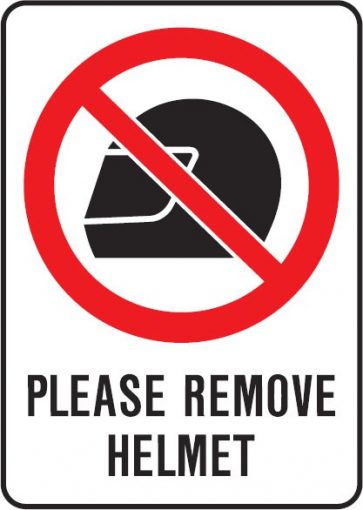We are all familiar with the security sign at the entry to buildings that clearly states that the removal of helmets is a condition of entry.
Primary reasons for the required removal of ‘face blockers’ are:
- It may deter criminals, such as armed robbers,
- It should assist identification of the offender or offenders. Offenders not apprehended tend to re-offend, and
- It supports safety risk management for staff and other people.
Furthermore, where workplaces have an armed offender risk, anxiety of front-line staff can increase when the faces of ‘strangers’ approaching or in their work-space cannot be seen.
 With COVID-19 there is a new face blocker issue. The pandemic has normalised the wearing of face masks. It is unlikely a security sign advising that the removal of face masks is a condition of entry will be seen anytime soon.
With COVID-19 there is a new face blocker issue. The pandemic has normalised the wearing of face masks. It is unlikely a security sign advising that the removal of face masks is a condition of entry will be seen anytime soon.
Face masks may diminish the benefits of CCTV and the security officer sometimes stationed to observe entry areas. Evaluation of security effectiveness is central to reconnaissance by criminals as part of their target selection process. Criminals may be emboldened due to their perception that security effectiveness is reduced when face masks are used.
It is likely personnel tasked to vet and control visitors (e.g. receptionists, concierge, security officer), can astutely and sometimes sub-consciously identify people wearing masks by various means, such as by their speech or their gait without requiring system-based assessment. However, this may lead to genuine human error. What about people they don’t know?
For the sake of good risk management, it is better to know the current limitations of your human and technical security risk controls, pertaining to a masked visitor.
Premises with an IP video surveillance system with artificial intelligence (AI) may have a chance to counter the mask problem. Speech and gait recognition may be worth assessing for your context. However, the true value will likely be limited as it will require people to be enrolled in the ‘system’.
AI is being used to reinforce physical distancing and other hygiene measures for COVID-19. There are other claims by security technology manufacturers, for example being able to see through masks. However, the objective assessment of surveillance technologies in your context by an independent subject matter expert should improve governance and your procurement decisions.
The use of AI in surveillance systems has met with some controversy largely due to certain nation states using it on their own population. Should your organisation have an ethics committee or an ethics consultant, the committee or consultant should be engaged as an essential part of the procurement process to ensure potential ethical issues related to AI are identified and questions from stakeholders satisfied.
When considering new security technologies, you would be wise to seek professional advice from your legal counsel to ensure compliance with any relevant workplace surveillance, privacy, data protection and human rights legislation, codes or international conventions.
A security risk assessment specific to the face mask issue in your context should be undertaken. Irrespective of the technology applications you deploy, security policies relating to electronic surveillance, security standing operating procedures (SOP) and security training should be re-evaluated and re-aligned to better manage the face mask issue.
Organisations that mitigate their security risks by requiring good human or CCTV views of faces should not delay thinking this through. A false sense of security and outdated risk assessments can be dangerous.
It should be expected that the wearing of face masks will be normalised behaviour for some people, especially if COVID-19 Mark 2 or a new pandemic hits us. If face coverings have diminished your security risk management, the situation requires focussed thinking and decisive action by managers. It should not go into the too hard basket.
Blog Update – Research by NIST
Since this blog was published, the (US) National Institute of Standards and Technology (NIST), in collaboration with the (US) Department of Homeland Security’s Science and Technology Directorate, Office of Biometric Identity Management, and Customs and Border Protection published the first of a series of reports from their Face Recognition Vendor Test (FRVT) program, asking the question ‘how well do face recognition algorithms identify people wearing masks?’
The program commenced testing how an algorithm developed before the pandemic might be affected by subjects wearing face masks. Later this year, NIST intends to test the accuracy of algorithms that have been intentionally developed with masked faces in mind.
NIST has drawn a few broad conclusions from the results with caveats.
- Algorithm accuracy with masked faces declined substantially across the board.
- Masked images more frequently caused algorithms to be unable to process a face, technically termed “failure to enroll or template” (FTE).
- The more of the nose a mask covers, the lower the algorithm’s accuracy.
- While false negatives increased, false positives remained stable or modestly declined.
- The shape and color of a mask matters.
It should be noted that there has been considerable advances and continuing research in developing algorithms for the new face masked world.
Source:
Before you invest…ensure you understand the test. Due diligence requires trusted subject matter experts.
Happy to discuss further.
Original Blog posted. June 8, 2020. Updated 3 August 2020 (NIST Research).
Geoff Harris
Principal Consultant
Harris Security Management – www.harris.com.au
Ph. 0419 462 798 (International +61 419 462 798)
Please note: This Blog provides general information only. It does not take into consideration specific contexts. We do not accept liability whatsoever for any expense, liability, loss or proceedings incurred or arising as a result of any error or omission in this Blog including research by others, or arising from any person acting, relying upon or otherwise using information from this Blog. You should seek professional assessment and advice and make your own judgement.
Happy to discuss further.

